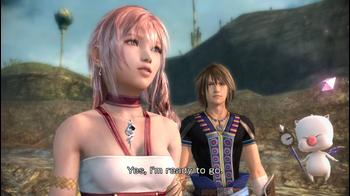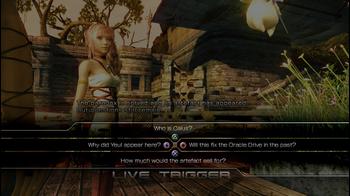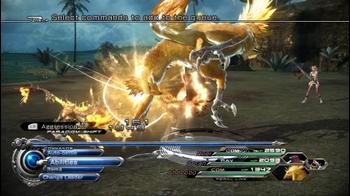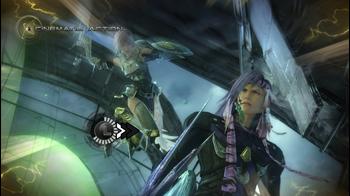
Final Fantasy XIII-2 Review
It's tough to write about Final Fantasy XIII-2 on this website because so much has already been said. We tackled hands-on previews at E3, TGS, Comic Con and even Square Enix's Los Angeles and London Offices and interviewed the bosses behind the game multiple times - we have really covered this game.
If you want back-story, all that is through this link - and import review from earlier this month is the best resource for that on the site and therefore recommended. It's massive, and tackles the nitty gritty of the game in intense detail - but here I'm going to break it down in the most simple way possible - what's great, what sucks, and what lies in between.
The story thrusts you into the role of two newly-playable characters - Serah, sister of FF13 protagonist Lighting, and Noel, a new guy designed, according to Producer Yoshinori Kitase, to help "make XIII-2's story a little bit darker and more mysterious." Noel doesn't necessarily do that, but he's a refreshing character who shares the role of protagonist jointly with Serah. Whilst Lightning was a clear lead surrounded by a cast of supporting characters, Serah and Noel are equally integral to the story and the game actually actively lets you choose which one you'd rather control whilst exploring and in battle.
Noel has a sort of boundless enthusiasm that harks heavily back to Final Fantasy IX, X and XII, three games that had mostly cheery leads. He's a joker, being vague in his answers to Serah's questions early on simply to spur on teasing dialogue between the two. He's a character that plays to the anime clichés of a strong, enthusiastic young male, but it works - he's the perfect foil for Serah, especially at a time of immense confusion.
Confusion is something FF13-2 is muddled on. I was impressed where as the game opened proper and the game shifted from the flashy opening sequence - the only sequence where Lightning is playable, if the word really applies to these heavily scripted battles - Serah seemed incredulous.
Her clothes had changed seemingly by magic, the past seemed to have been altered from what she - and the player - remembers from FF13, and questions asked out loud in a voiced thought process were questions I would actually ask. That sadly disappears as the game progresses, with leaps of logic used throughout to justify what can only be described as poor plotting. The story literally performs lurching back flips to connect the dots, and things feel no clearer localized. If something isn't making sense, remember that a time paradox is probably responsible - as that's the only explanation you're going to get.
Noel and Serah are well written ciphers for the player that have genuinely interesting interactions, and the few characters from FF13 who are reused in a large capacity - one in particular - are used well. Lightning is gone, but I didn't miss her. Mog, Serah's Moogle companion, is cute, functional from a gameplay perspective and thankfully falls short of being annoying.
The main significant story-based addition is the 'Live Trigger' - a dialogue choice system that vaguely resembles those seen so heavily featured in Western RPGs over the years. At key moments in the story and in conversations with certain NPCs, Serah and Noel will be faced with a choice where they can choose one of four options.
Based on what you say different dialogue will be kicked out, but this is often a one-time deal - you can't ask again. Certain decisions will also yield item rewards, so careful choice is advised - but other than that these choices are of no consequence, having no actual effect on the flow of the story, just minor pieces of NPC dialogue.
The English voice cast generally put in a stellar performance, with particular props due to Noel's voice actor who brings the new boy to life perfectly. The voice cast and localization team have clearly worked brilliantly with the material they were given, polishing it to a sheen and presenting it well.
The story is full of brilliant flair like this - the in-engine cutscenes make a fantastic case for Square Enix to use less CGI, as incredible as visual works rendering is, and is well directed and pretty-looking - and it gets rid of the nasty compression on the Xbox 360. Small touches like how the text that denotes what Chapter you're in appears are incredibly well realized and give the game a cinematic flair that surpasses the first.
It's a shame that some characters seem to make strange decisions and statements that go against their established natures as the story goes down this strange path of being almost entirely about hero-worshipping Lightning.
There's far more interesting things going on, like unexplained paradoxes and weird rifts in time and space that warp the terrain around you with a snazzy graphical effect - but all anyone cares about is Lightning. It's saddening that the plot these solid characters are in is often muddled and messy and ultimately leads to an extremely unsatisfying conclusion that leaves as many questions remaining as it answered.
Time travel can be used to great effect, as fans of Square Enix's Chrono series will attest. Like those games, 13-2's time travel is used heavily as a gameplay mechanic, this time allowing players to revisit and replay areas from earlier in the story to obtain more insight, grab hidden items and experience story again. The game's time travel hub Historia Crux is available at pretty much any point in the game, but the end result is a constant, consistent lack of urgency.
The game is deliberately laid back, encouraging you to revisit old areas, but in being so it lacks the tension that FF13's fairly compelling early plot of being 'on the run' had. There's no real sense of urgency to move on quickly, because Lightning will wait and you can time travel anyway. It's a contextual thing, clearly, as Chrono Trigger maintains a clear and exciting pace throughout whilst having freedom of time travel.
In gameplay terms the Historia Crux and the time travel is much more successful, bringing a satisfying change. The ability to go back on yourself and grind, find more loot, complete side quests or even just experience alternate takes on dialogue and scenes you from before in an earlier part of the story is a gratifying and surprising amount of freedom after FF13's more limited approach to player freedom.
Some side quests even require the player to have completed later areas before tackling them. It's a shame the story fails to utilize the crux as well as the gameplay does, as the way it's leveraged to add replay value is very welcome.
Areas in FF13-2 are mostly no longer linear corridors, splintering out into networks of smaller passages, far more reminiscent of older titles in the series as a result. Treasure and fragments will be hidden off in far-flung corners of places, whilst NPCs who give side quests will be found lurking in a variety of locations. Area assets are reused as you see them in different time periods, but sadly area layouts don't really change much in different periods - presumably too much to build.
The side quests themselves often amount to simple fetch quests, but the combat challenges and optional map areas they'll point you to make them worthwhile. Best of all, these NPCs have unique dialogue and back stories that play out through the quests you complete. While the actual quest objectives could be a little more content rich, they're satisfying and again reminiscent of older titles in the series in a very positive way.
The monster system, something which polarized fans at first, is something I could see being fondly remembered as one of the more interesting additions to the series. Part Pokémon, part job system, it allows you to capture monsters and then pull them in as your third party member. Loot gleaned of the bodies of defeated enemies can then be applied to monsters to help them level up through their own personal character progression.
Monsters enhance the already clever paradigm shift system of FF13 and give the player a surprisingly significant layer of freedom over the previous title. Monsters can become the basis around which a solid battle strategy is built, and monsters are the only way to learn some very handy spells such as buffs Haste and Slow. In general, they feel like a far more useful feature than FF13's summons.
Constructing paradigms is more interesting now as the third party member can actively change in each paradigm you save, meaning your defence paradigm could see you working with Cait Sith and your offensive one could see you using a Chocobo. As well as progression monsters can be decorated, so if putting sunglasses on a Chocobo is your thing consider your day made - I can't say I bothered with the that - building battle strategies was far more interesting.
Monsters are a welcome, fun addition, and like Final Fantasy X-2's sphere grid - branded as stupid dress-up at the time - I think will be treated much more kindly by fans of the series in a few years after the furore over Lightning and the rest of FF13's cast being unplayable dies down. They add a ton to the experience, and tweaking and levelling monsters and putting them into paradigms is where much of my time was spent.
Serah and Noel hit FF13's Crystarium for progression, but this time it's fully unlocked from early in the game with no chapter restrictions - if you want to power level, more power to you - this time, the game will let you. More freedom is definitely a welcome change, and one that led to me putting more time into levelling up and customising Serah and Noel to fit certain combat roles better.
Other small tweaks and changes to the battle system buff its overall quality, including the major decision to allow you to change party leader mid-battle, meaning that party leader death no longer leads to a Game Over screen.
Also slight-sounding but significant is the general battle speed, which feels far quicker than FF13. In general, though, you'll still spend your time hammering auto battle whilst watching the stagger meter, ready to change paradigm. The ability to set an AI style for the AI-controlled characters in battle is also extremely welcome.
Battles in FF13-2 generally look more dynamic, with Noel and Serah sporting some slick-looking battle animations. This is at its best in the impressive-looking opening sequence as Lightning rides atop Odin battling Bahamut. Odin animates beautifully as you control the battle, contextually jumping over balls of fire fired by Bahamut as they hit the ground. The game's opening is full of presentational flair in its battles, though they also underline a general problem with both FF13 games - you're not in control of any of it.
Square Enix's solution to this is Cinematic Actions, QTEs that put you in control of a portion of those awesome moments. They look cool, are well-handled and failure only gives you damage and stagger buffs, meaning failure will never lead to a game over - a wise decision.
Cinematic Actions aren't enough, though, and I still found myself far too detached from regular battles. Even Cinematic Action style prompts when you perform your 'Feral Link' with a monster (think Limit Breaks) aren't enough to draw me back in - more is needed. Also to blame for my ability to sometimes mentally disengage from battle is a ridiculously easy difficulty throughout.
I left FF13-2's battle system with only the two niggles above to speak of. Pretty much every aspect is improved over FF13 - but it's not the best part of the game. That honour belongs to the soundtrack, a wonderful, whimsical mixture of searing strings and touching piano from Masashi Hamauzu as well as contributions from a handful of other composers including some really brave and brilliant use of vocal tracks. I know that metal Chocobo mix is bloody awful, but one or two clangers on a seventy-plus track score is quite acceptable.
One major gameplay addition varies in quality - the puzzles in Historia Crux. These puzzles are used to unlock new areas and all take place on the Crux's ethereal plane. I didn't hate them as Erren did in the import review, but I can say that they felt like unnecessary filler and after the first few puzzles the novelty very quickly wore off. This one is something to perhaps iterate on in future games, but the selection of other mini-games including Chocobo Racing and the Casino are great fun and a decent time sink.
In performance terms a shorter development time is slightly visible in an overall diminished amount of polish to the visuals, but FF13-2 is still a very pretty game, especially in well choreographed real time cutscenes. It's a valuable lesson that expensive CGI isn't always the answer.
It's generally a more even game, with texture quality more consistent across all areas, more great-looking real time story sequences and pretty close to identical looks on both formats. It's difficult to call either of the FF13 games the better technical achievement, but FF13-2 is certainly more consistent in what it has to offer.
Final Fantasy XIII-2 is a better game than Final Fantasy XIII; that much is clear. It sounds better, doesn't have a 'worse' version this time around, carries a bunch of substantial side quest and post-game content to add replay value, but most notable of all it has a grossly improved battle system that is a hell of a lot more fun.
That makes it an even bigger shame that the story quickly becomes a muddled, lacking mess and fails to redeem itself. It's almost hard to believe a character as likeable as Noel has been written by somebody who has created a story as inept as this - and even harder to believe that FF13, which lacked a strong villain but had a strong narrative thread, was by the same person. We all have our off days, but this is a particularly striking one.
Story is Final Fantasy XIII-2's downfall, and in that area it falls hard - but thankfully it shines more than enough in other areas to redeem that fact. It is in general a much-improved, fun experience - it's just wrapped in an often nonsensical story that is almost ruinous to the rest of the game. Despite that, Final Fantasy XIII-2 is definitely worth the time of even those who were disappointed by the original title, as many problems have been brilliantly and tactfully addressed.
Disclaimer: Square Enix provided RPG Site with final retail code of Final Fantasy XIII-2 for the purposes of this review. Versions Tested: PS3 (Primary), 360.







_PS3_02 copy.jpg)